NCERT-Solutions-Class-6-Science-Motion and Measurement of Distances
NCERT notes along with solutions for class 6: science – Chapter “Motion and Measurement of Distances” are provided here. The notes as well as solutions are very much helpful for the students to understand the topic. The solutions will be handy for quickly completing the homework and preparing for exams.
Table of Contents
ToggleEvolution of transportation
- In ancient times, people used to move only on foot as they did not have any means of transportation.
- Later on, inspired by the shape of water animals boats were made and were used to cross water bodies.
- After invention of wheel, carts pulled by animals were used for transportation.
- Invention of steam engine led to the development of new means of transportation like railway, ships etc. and later came motor cars, trucks, buses etc.
- In 20th century, electric trains, monorails, supersonic aeroplanes, and spacecraft were the modern means of transportation system.
Physical quantity
- Those quantities which can be measured are known as physical quantities.
- For example – length, mass and time.
- There are two types of physical quantities
- Fundamental Physical Quantities
- Derived Physical
Fundamental Physical Quantities
- Basic physical quantities that do not depend upon other quantities are called fundamental physical quantities.
- There are seven fundamental physical quantities:
- length
- mass
- temperature
- time
- electric current
- luminous intensity
- the amount of substance

Derived Physical Quantities
- Physical quantities that are derived from one or more fundamental physical quantities are called derived physical quantities.
- For example – speed, area, acceleration, force etc.

Measurement
- Measurement means the comparison of an unknown quantity with some known quantity.
- The result of a measurement is expressed in two parts.
- the unit
- the number indicating how many units there are in the quantity being measured
For example: When we say the length of a cloth is 10 metres. We compare the length of the cloth with the standard unit of length called metre. And 10 metres means the length is ten times the standard quantity of length i.e. 1 metre.
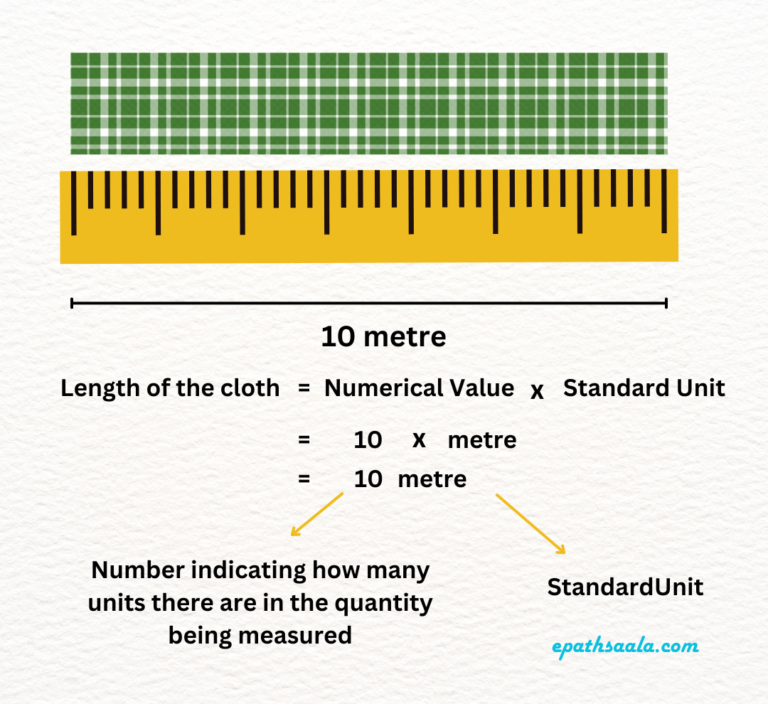
Unit
Measurement of any physical quantity involves comparison with a certain basic, internationally accepted reference standard called unit.
Unit of Measurement
There are two types of units of measurement:
- Standard Unit
- Non-standard Unit
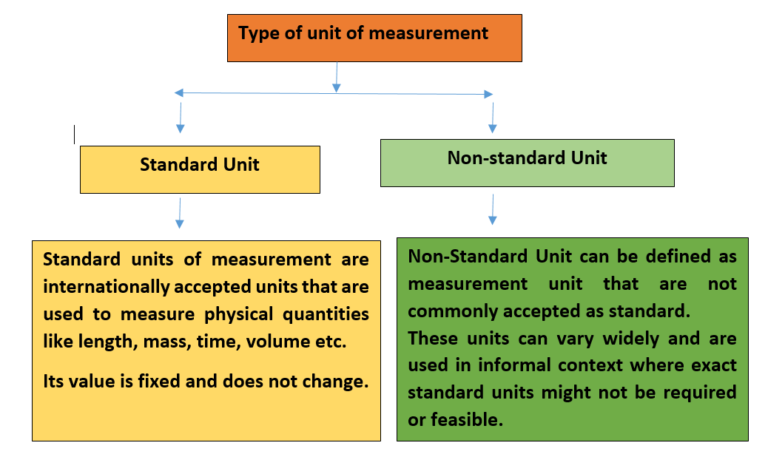
Standard unit of measurement
- Standard units of measurement are internationally accepted units that are used to measure physical quantities like length, mass, time, volume etc.
- The measured value remains the same i.e. fixed when measured by anybody at any place.
System of Units: CGS, FPS, MKS, SI
CGS System
In this system, the unit of length is centimetre, the unit of mass is gram and the unit of time is second.
FPS System
In this system, the unit of length is foot, the unit of mass is pound and the unit of time is second.
MKS System
In this system, the unit of length is metre, unit of mass is kg and the unit of time is second.
International System of Units (SI)
- For the sake of uniformity, scientists of all over the world have adopted a set of standard units of measurement. This system of units is known as International system of units (SI Units).
- In French it is called – Systeme Internationale d` Unites.
- This system is an improved and extended version of MKS system.
- The symbols, units and abbreviations of SI were developed by the International Bureau of Weights and Measures in 1971.
- In SI, there are seven base units – length, mass, temperature, time, electric current, luminous intensity and the amount of substance.
Base Quantity | SI unit | Symbol |
Length | metre | m |
Mass | kilogram | kg |
Temperature | Kelvin | K |
Time | Second | s |
Electric current | Ampere | A |
Luminous intensity | Candela | cd |
Amount of substance | Mole | mol |
Motion and measurement of distances: length
- The distance between one point and the other desired point is known as length.
- The SI unit of length is metre and it is represented by the letter “m”.
- For measurements of very small length, either millimetre (mm) or centimetre (cm) is used.
- For measuring larger distances, metre (m) or kilometre (km) is used.
Instrument for measurement of length
- Some of the standard instruments used to measure length are: ruler, meter scale, measuring tape, vernier calliper etc.
Correct measurement of length
- In taking measurement of a length, we need to take care of the following:
- Place the scale in contact with the object along its length.
- In some scales, the ends may be broken and it is not possible to see the zero mark clearly. In such cases, it is advised to avoid taking measurements from the zero mark of the scale. You can use any other full mark of the scale and then subtract the reading of this mark from the reading at the other end.
- For example, if the reading at one end is 1.0 cm and the other end is 14.3 cm. then, the length of the object is – (14.3 – 1.0) = 13.3 cm.
- The eye must be exactly in front of the point where the measurement is to be taken.
Measuring the length of a curved line
- Take a thread to measure the length of a curved line AB.
- Put a knot on the thread near one of its ends and place this knot on point A.
- Place the thread along the line till it reaches the point B of the curved line.
- Make a mark on the thread where it touches the end B.
- Now stretch the thread along a metre scale and measure the length between the knot in the beginning and the final mark on the thread.
- This gives the length of the curved line AB.

Conversion of km to mm and vice-versa
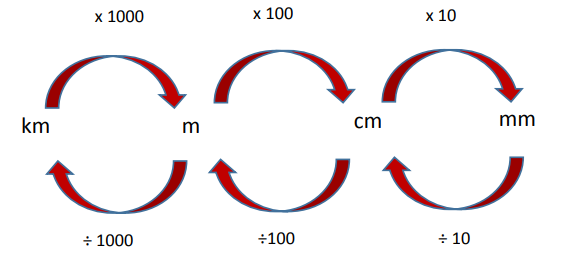
Parallex error
- Parallax error is the error that occurs due to incorrect positioning of the eyes while taking a reading on the measurement scale.
- While taking a reading, your eye must be perpendicular to the reading point on the scale otherwise viewing from a different angle you will get less or more value of the measurement than the actual value.
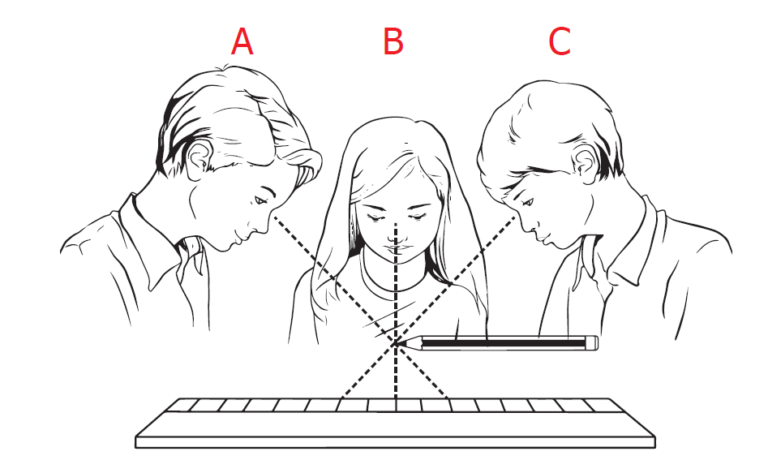
Non-standard unit of measurement
- In ancient times, people generally used the following non-standard units to measure the length of an object:
- Length of a foot
- Width of a finger (angul)
- Cubit – length from the elbow to the finger tips.
- Yard -length between the end of the outstretched arm and their chin.
- Fist
- Stride
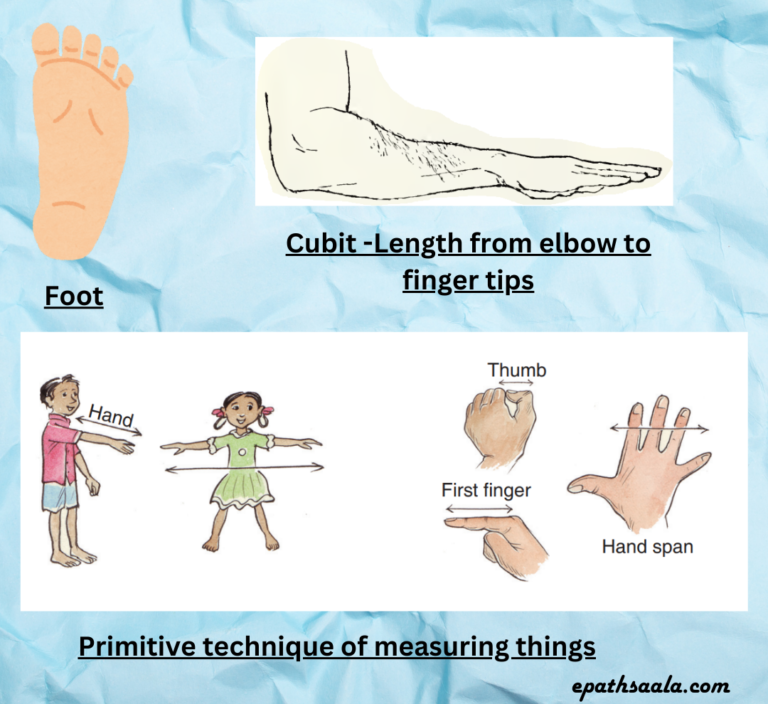
Problems in measurement of Non-standard unit of measurement
- The non-standard units were not uniform as the length of a foot, hand-span and cubit varied from person to person according to their body size.
- Hence, these units could not be used for measurement where the main concern was accuracy.
Motion and measurement of distances: Motion and its type
Motion
- A body is said to be in motion when it changes its position with respect to time and its reference point.
- For example – when an athlete runs on a ground full of spectators. He continuously changes his position with respect to the spectators who are sitting at rest.
- A push or pull will result in bringing some motion in an object.
Types of motion
- Motion can be categorized into several types:
- Translatory Motion
- Circular Motion
- Rotatory Motion
- Oscillatory Motion
- Periodic Motion
Translatory Motion
- Translatory motion is the motion in which each particle in a body moves over the same distance in the same amount of time in the same direction.
- All points of a moving body move uniformly in the same line or direction during this sort of motion, and there is no change in the body’s orientation with respect to a fixed point.
- Example – The motion of an apple falling from a tree, the motion of a box when pushed from one corner of a room to the other etc.
- There are two types of translatory motion.
- Rectilinear Motion
- Curvilinear Motion
Rectilinear Motion
- When a body moves in a straight path then that motion of the body is called rectilinear motion. Key points in rectilinear motion:
- Direction: the body moves in a single direction without changing the course.
- Speed: the speed of the object can be constant or variable.
- Example – the motion of a bullet fired from a gun.
Curvilinear Motion
- If a body moves along a curved path then it is said to have curvilinear motion. Key points In curvilinear motion:
- Curved path: the body follows a path that is not straight. The path can be circular, elliptical or any other curved shape.
- Changing direction: the direction of the body changes continuously as the body moves along the curve.
- Variable velocity: the velocity of the body is variable as the speed and direction of the body change over time
- Example – the motion of a cyclist while taking a turn on the road.
Circular Motion
- An object is said to be in circular motion when it moves around a fixed point called the centre of the circle. Key points in a circular motion:
- Circular path: the object follows a circular path. This means the distance from the object to the center of the circle remains the same.
- Constant Speed: In a uniform circular motion, the speed of the object remains constant. However, the direction of the object changes continuously as the object moves around a circle.
- Example – a spinning top rotating on a flat surface.
Rotatory Motion
- It refers to the movement of an object around a fixed axis. Key points in rotational motion:
- Axis of rotation: the object rotates around a specific axis or point.
- Angular displacement: It measures the angle through which an object rotates on its axis.
- Angular velocity: It describes how fast the object rotates around its axis.
- Example – Rotation of a fan.
Oscillatory Motion
- Oscillatory motion is a type of periodic motion in which an object moves to and fro from its mean position. Key points in oscillatory motion:
- Equilibrium position: In oscillatory motion, the motion occurs around an equilibrium point where the object tends to return after displacement.
- Periodic motion: In oscillatory motion, the object repeats the movement over regular intervals of time.
- Example – oscillation of a simple pendulum.
Periodic Motion
- A motion that repeats itself after a regular interval of time is called periodic motion. Key points in periodic motion:
- Regular interval: It occurs at regular intervals of time.
- Repetition: The motion repeats itself identically over successive cycles. This means that the object returns to its original position, velocity or state after each cycle.
- Example – the motion of planets around the sun.
Solution of the exercise
Q1. Give two examples each, of modes of transport used on land, water and air.
- Mode of transportation on land – Cars & Trains
- Mode of transportation on water – Boats & Ships
- Mode of transportation on air – Aeroplane & Helicopter
Fill in the blanks
- One metre is ___________ cm.
- Five kilometre is _________ m.
- Motion of a child on a swing is __________ .
- Motion of the needle of a sewing machine is __________ .
- Motion of wheel of a bicycle is ___________ .
- 100 cm
- 5000 cm
- periodic motion
- periodic motion
- circular motion
Q3. Why can a pace or a footstep not be used as a standard unit of length?
Ans: A pace or a footstep cannot be used as a standard unit of length because the size of a pace or a footstep of every person is not uniform. It varies from person to person according to their body size. As a result, different results will be obtained when measured by different persons.
Q4. Arrange the following lengths in their increasing magnitude?
1 metre, 1 centimetre, 1 kilometre, 1 millimetre
Ans: As we know that,
1 km = 1000 m = 100000 cm = 10000000 mm.
Hence, 1 kilometre > 1metre > 1centimetre > 1millimetre
Q5. The height of a person is 1.65m. Express it into cm and mm.
Ans: As we know that:
1 m = 100 cm = 1000 mm
Hence, 1.65 m = 16.5 x 100 = 165 cm
And, 1.65 m = 1.65 x 1000 = 1650 mm
Q6. The distance between Radha`s home and her school is 3250 m. Express this distance into km..
Ans:
We know that: 1 m = 1/1000 km
Hence, 3250 m = 3250/1000 = 3.25 km
Q7. While measuring the length of a knitting needle, the reading of the scale at one end is 3.0 cm and at the other end is 33.1 cm. What is the length of the needle?
Ans:
The length of the needle = 33.1 – 3.0 = 30.1 cm
Q8. Write the similarities and differences between the motion of bicycle and a ceiling fan that has been switched on.
Ans:
Similarity: Motion of a bicycle and a ceiling fan both shows a circular motion because both the things are moving around a circular path from a fixed point.
Differences: A bicycle shows a rectilinear motion whereas a ceiling fan exhibits a circular motion.
Q9. Why would you not like to use a measuring tape made of an elastic materials like rubber to measure distance? What would be some of the problems you would meet in telling someone about a distance you measured with such a tape?
Ans:
A measuring tape which is made up of an elastic material like rubber is generally stretchable and will give same results for different lengths. When we express measurements taken with elastic tape, we have to tell whether the tape was stretched. If yes, how much? At that moment, it is very difficult to tell the measurement taken from an elastic tape.
Q10. Give two examples of periodic motion
Ans:
- A needle of a sewing machine
- Pendulum